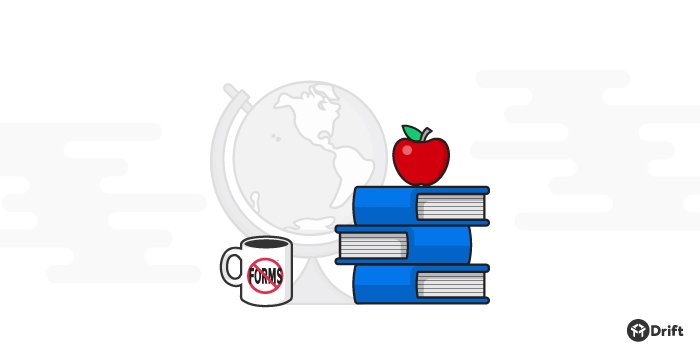
What is gated content?
Gated content is any type of content that can only be accessed after a website visitor has provided some of their information. This requested information almost always includes the visitor’s email address and is usually requested through a lead form.
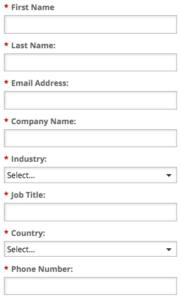
The day we killed gated content
Last year, our CEO David made the call: There would be no more gated content on the Drift website.
And by “made the call,” I mean he literally called our director of marketing (Dave) and told him: “Hey, I think we should get rid of all our lead forms”.
Needless to say, Dave was a bit surprised by the news. After all, he’s the one heading up the team that’s supposed to be generating and qualifying leads for our sales team.
How the heck was he supposed to do that without lead capture forms?
But once our CEO explained his thinking a bit more, it all started to come together. Here’s what he told us:
I think marketing has kind of lost its way a little bit. We’ve lost the importance of a great story and truly connecting with people. We live in this world where it’s all about content, content and more content. And SEO. And ranking for this keyword and that keyword. And algorithms and conversion rate optimization. Pieces of that stuff are still important to marketing, but overall, I think we’ve lost our way. Marketing today has become more about gaming the system and get rich quick schemes.

Over the past year, we’ve been focused on reinventing the way we do marketing and sales. And it all started with getting rid of our lead forms and making content free (non-gated content).
Here are a few things we learned along the way.
1) Non-gated content is more powerful.
Getting rid of lead forms forced us to rethink our entire content strategy.
The traditional approach had been to put your shorter, quicker-hitting stuff up on the company blog, and then save your long-form or “premium” pieces for hiding behind a landing page form.
The game then became to write as many blog posts as possible that were (at least somewhat) related to those “premium” pieces of gated content, so you could keep linking back to them and keep making people fill out forms.
That’s how a lot of marketing teams have been approaching content and lead generation for the past decade. And as a result, many company blogs have turned into content farms. Instead of creating content with the goal of adding value and building trust, a lot of us have been optimizing for volume and creating gated content simply to hit our lead goals.
So over the past year, we tried doing things a little bit differently.
- We stuck to publishing just 1-2 posts per week on our blog. (Meanwhile, some companies publish 5+ posts per day.)
- We treated content primarily as a branding tool, not a lead gen tool. (We were more focused on crafting compelling stories vs. SEO and keywords.)
- We started looking at qualitative metrics in addition to the quantitative ones. (Getting positive feedback from customers and influential people in your industry = a good indication your content is resonating.)
- We threw out the traditional ebook playbook and wrote our own. (This involved self-publishing a book on Amazon and giving it away for free in PDF, EPUB, and MOBI formats.)
Now, if we had used the old approach and stuck that book behind a landing page form, we probably would have generated a decent amount of leads … But then the marketing team wouldn’t have gotten this Slack message from our Customer Success manager Isabella:

In the message, she’s referencing someone who had just reached out asking for some tips on using Drift. If our book had been hidden behind a landing page form, that probably wouldn’t have happened.
2) “No gated content” doesn’t mean “no leads.”
Look, we get it. Moving away from gated content is a scary prospect. Because without those lead capture forms in place, it becomes nearly impossible to generate leads, right?
Wrong.
Over the past year, we discovered that it’s not only possible to generate leads 100% through messaging, but also that messaging does a much better job at generating leads. It’s able to catch people that used to fall through the cracks.
Here’s why:
A lead form is static. It’s a cold and impersonal way of welcoming a potential customer to your website. All it does is sit there on the screen, waiting for information to get entered. It can’t answer questions, and it can’t ask questions to help make sure the people filling it out are a good fit for your product.
And when someone does fill out a form, guess what? They start receiving boatloads of automated emails that are meant to “nurture” them.

This is the traditional approach to moving people through your sales & marketing funnel. Not surprisingly, more and more buyers are getting fed up with it.
In a world where billions of people are now using messaging to communicate in real-time, why would anyone want to fill out a form and wait for an email?
By switching to live chat for generating leads, we opened up a communication channel that let’s potential customers get in touch when it’s convenient for them — while they’re live on our website.
As our numbers guy, Will, explains in the video below, this doesn’t just provide a better experience for buyers, it’s better for your bottom-line.
Email is like a dude who sits on side of the road at a stoplight with a sign and says, “Hey, pull into my store, pull into my parking lot.” Super high volume, low conversion rate kind of play. You send out 300 emails to get 30 replies, three demos, and these are best in class metrics, just to get to one deal.
Now, let’s think about chat. Chat, to me, is like the Apple employee that greets you when you walk into the store and says, “Hey, how can I help you?” With chat, you have 20 conversations (by the way, these are numbers that we see every day.) You have 20 conversations, and 16 of those are support-related, four of those are sales-related, but they’re warm leads, so one out of those four is going to convert into a deal.
So, which would you rather have? Would you rather have 300 conversations to get to one sales deal through email and deal with the content creation and the follow-up? Or would you rather have 20 live conversations in chat to close a deal?
3) Bots can help make the lead qualification process more efficient.
The ideal timeframe for responding to a new lead is within the first five minutes, according to research from InsideSales.com and Harvard Business Review.
Respond in ten minutes instead of five? You’re looking at a 400% decrease in your odds of qualifying a lead.
And to me, this decrease makes a lot of sense. Because if I’m trying to decide between competing products, and one company is able to answer my questions and let me book a product demo right away, and the other makes me fill out a form and wait a day or an hour or ten minutes before I’m actually able to talk to anyone, that first company is going to have an edge.
Earlier this year, we tested the response times of 433 B2B sales teams, and found that just 7% were following up with new leads within the first five minutes (see Is Your Lead Management Leaking?).
The majority of teams (55%) took 5+ days to respond or didn’t respond at all.
You can see the full breakdown below:
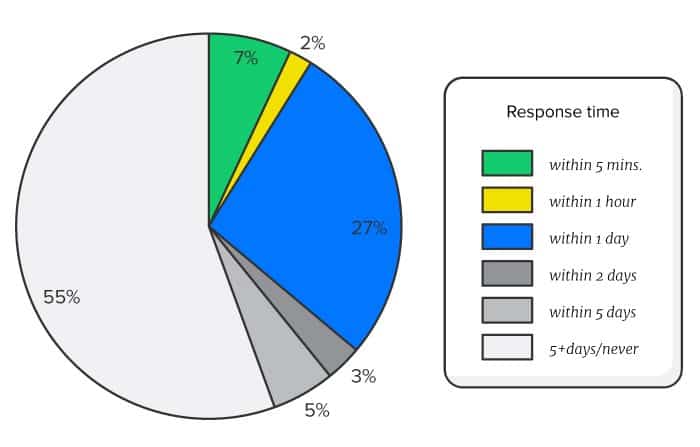
The sales teams with the fastest response times all had one thing in common: They were using messaging to engage with leads in real-time.
For a lot of teams, however, chatting with leads in real-time might seem impossible, or impractical. After all, there might be hundreds of conversations happening over the course of a single day. How could you manage all that? How could it scale?
The answer: bots for BDRs.
At Drift, chatbots are integral to our sales & marketing process. For example, we use them for…
- routing chats to the right department (e.g. sales, support), as well as to the right sales rep based on territory

- responding to questions that we already have answers for in our help desk
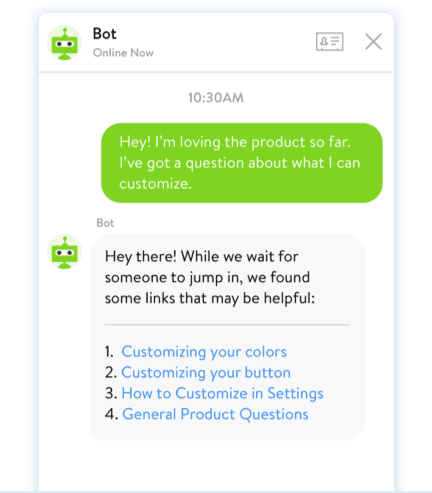
- capturing and qualifying leads on high-intent pages (via targeted LeadBot campaigns)
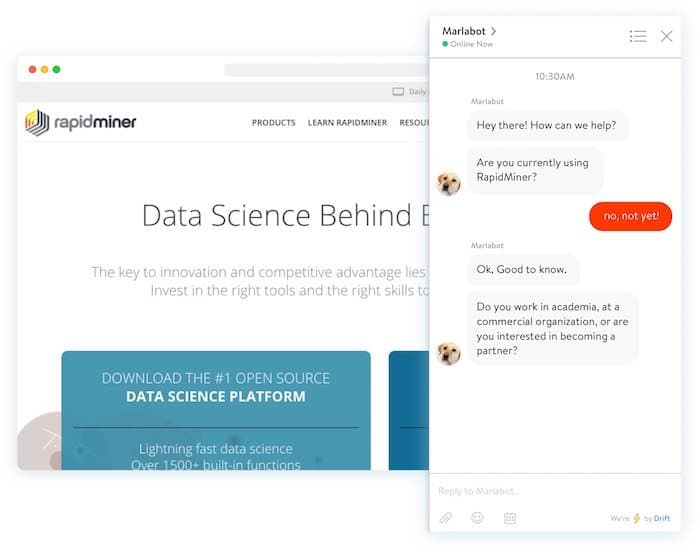
And specifically, using our LeadBot chatbot, we’re able to qualify leads in real-time, 24/7, even when all of our sales reps are asleep. We just take the questions our sales reps are already asking and turn them into a script.
The first LeadBot campaign we ever created is still running on our pricing page. It pops up in the corner and asks, “What brought you here to check out Drift?” before continuing with a couple more qualifying questions.
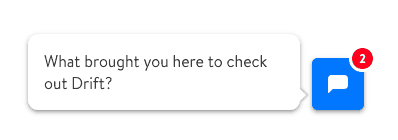
Of the people who click on that message, 63% of them end up starting a conversation with one of our sales reps.
(For comparison, the benchmark email click rate from MailChimp data ranges from 2% to 3%.)
Over the past year, we’ve learned that bots aren’t here to replace you or your sales & marketing team, they’re here to help (see our bot vs human piece). By taking care of the tedious tasks and filling in the gaps when your team is offline, bots can help make your sales and marketing process more efficient.
☝ Tweet this ☝
4) Messaging is the perfect complement to Account-Based Marketing (ABM)
Account-based marketing (ABM) targets individual, pre-identified accounts with personalized content and campaigns. Instead of fishing with a net, hoping to pull in as many leads as possible (re: content marketing), with ABM you’re fishing with a spear.
So why would you ever make someone from one of your target accounts fill out a form and wait for a follow-up?
With messaging, you can be available to answer questions at a moment’s notice. And if you turn on push notifications, you can be alerted in real-time when a potential customer is live on your site, so you can reach out preemptively.

Of course, bots can also help you get in touch with your target accounts.
Over at Segment, for example, they’re using our bot to target a defined set of companies based on lead score, and are then sending website visitors from those companies personalized messages. They’re able to accomplish this using IP address → domain matching powered by Clearbit.

This is the type of white-glove treatment you should be giving the folks in your target accounts. When they land on your website, you should be saying hello and engaging with them right away, not throwing forms in their faces and telling them you’ll follow up later.
5) You don’t have to quit forms & gated content cold turkey.
Look, I’ll admit it: Maybe sometimes, just sometimes, we can be a bit hard on lead capture forms. And pretty much for this entire month, we’re going to be talking about their pitfalls.
But even here at Drift, we have a form on our site — it’s a subscription form for our email newsletter. It’s a holdover from the pre-messaging era that we’re still working on transitioning over. (Current conversion rate: 2.2%. Womp womp.)
The takeaway here is that you don’t have to quit forms entirely in order to start benefiting from messaging.
A lot of our customers, including Segment, are using messaging as a “second net.” They’ve left everything else the same and are simply adding messaging as a new channel for capturing and qualifying leads.
The results?
Today, messaging is Segment’s number one source of qualified leads, and has been the strongest contributor to their growth year-to-date.



